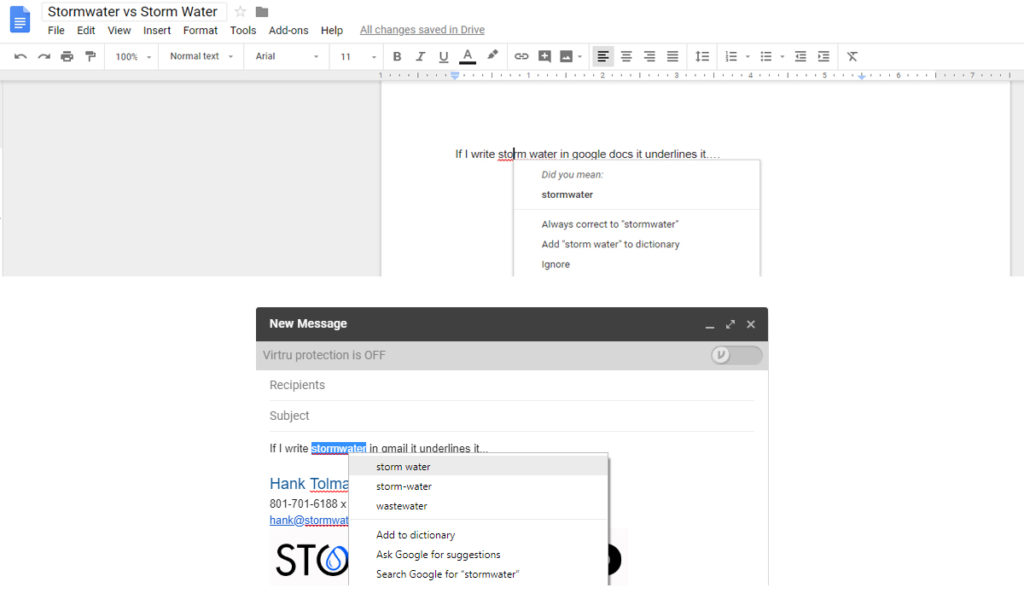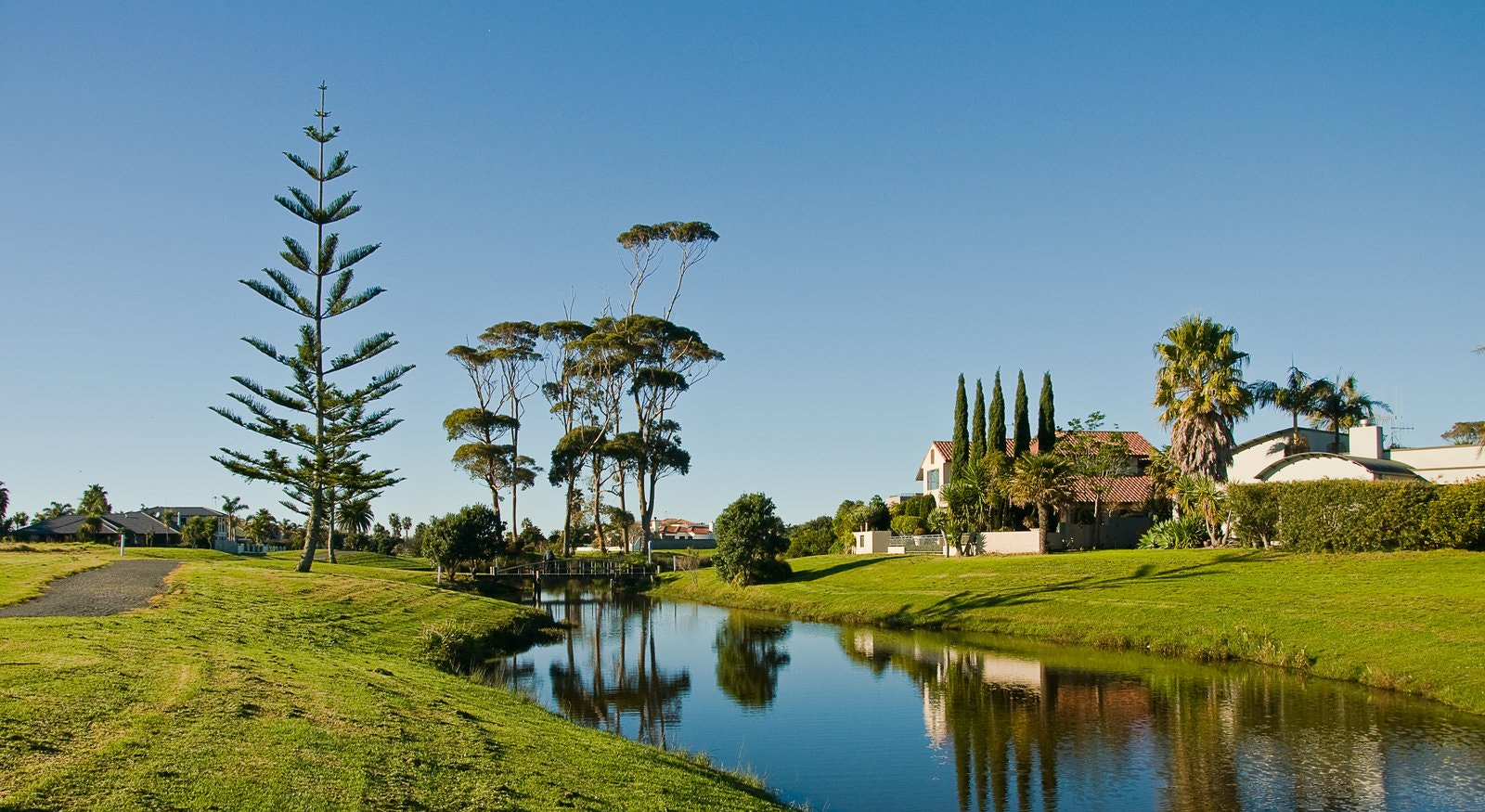Stormwater vs Storm Water
Is it one word? Two words? Hyphenated?
If your job involves any type of clean water regulation, you have probably come across this conundrum. What is the correct way to spell stormwater? Or is it storm water?
I am writing this article in Google Docs. When I write storm water as two words, it gives it a squiggly red underline and asks me if I mean stormwater. In complete contrast, when I send an email through Gmail, it tells me the word stormwater is misspelled and asks me if I mean storm water or storm-water. So if you thought google would know which one was correct, you’d be wrong. It can’t even decide for itself which one to use.

Don’t worry about it though, I have researched this life or death issue and finally come across the answer. From this day forth, you will know with certainty which of the two is correct. Is it stormwater or is it storm water?
And the answer is……
It’s both, but the “more” correct one seems to be stormwater as a single word, at least it seems to be now. Let me explain.
The history of stormwater control starts with the Clean Water Act in 1972. The closest I could find to the original text was the 1977 amendments which kept almost all of the 1972 wording of the Federal Water Pollution Control Act. The interesting thing about the 1977 version (which continues through all subsequent versions) is that it uses both spellings!
That’s right. The original document on stormwater regulations can’t even decide on a consistent spelling. Section 105 of the FWPCA states, “… eliminating the discharge into any waters of pollutants from sewers which carry storm water or both storm water and pollutants.” Various sections continue to reference storm water as two words up until we get to section 402, which talks about the National Pollutant Discharge Elimination System (NPDES).
Starting in section 402, we see the appearance of the word stormwater as a single word. “Stormwater Runoff from Oil, Gas, and Mining Operations…” and “.. for discharges of stormwater runoff from…” The rest of the document then refers to stormwater as a single word all the way up to the very last mention of the word in section 516, where it goes back to calling it storm water. This trend continues all the way to the latest version of the FWPCA in 2002 which still contains both usages of stormwater and storm water. This makes it seem like it really doesn’t matter which one we use.
Stormwater as One Word
While the FWPCA doesn’t seem to care which version is used, all recent permits that I could find from the EPA and specifically the NPDES use stormwater as a single word. Take, for example, the 2017 Construction General Permit. That document exclusively uses stormwater as a single word, as do the other permits.
The EPA website isn’t so consistent, however. The site explaining stormwater drainage wells uses the two spellings interchangeably; at some points referring to stormwater and at others referring to storm water (and even once spelling it stormater). Here you can see all three within two paragraphs.
“Class V stormwater drainage wells are use subsurface infiltration to manage surface water runoff (rainwater or snowmelt). Stormater drainage wells may have a variety of designs and are often referred to by names that include:
Dry wells
Bored wells
Infiltration galleries
The names can be misleading so it is important to note that storm water drainage wells like any well is defined in the UIC regulations (40 DFR144.3) as:”
On another page, talking about NPDES Stormwater Webcasts, the hyphenated storm-water spelling shows up.
Overall, however, the vast majority of EPA documentation uses the spelling of stormwater as a single word. Most of the webpages, permits and other current documents stick to stormwater, with storm water and storm-water (and stormater) only showing up occasionally.
The States
The battle for dominance gets even hotter; however, when we bring the states into the mix. Most states, like the EPA, can’t decide which version they want to use. It looks like Ohio has opted for storm water as two words in most of their stuff. The state of Texas seems to want to use stormwater as one word, but they can’t get their Department of Transportation on board. TxDOT insists on using storm water as two words in a lot of places.
Most states vary back and forth, but with most of the state permits using the federal permits as a guide (and sometimes just copying it outright), most of the permits stick to the one-word answer.
Conclusion
So in the end, it is my opinion that the EPA wants to consistently use stormwater as a single word in their official permits and documents. For this reason, I believe that is the correct way to spell it. There are plenty of official documents and places that spell it storm water and even storm-water, though, so if that’s your cup of tea, go for it! In the end, it doesn’t matter which way we spell it, as long as we take care of it.
References:
https://www.epa.gov/npdes/npdes-stormwater-webcasts
https://epa.ohio.gov/dsw/storm/index
https://www.epa.gov/uic/stormwater-drainage-wells
https://www3.epa.gov/region9/water/npdes/stormwater.html
https://www.gpo.gov/fdsys/pkg/CFR-2011-title40-vol22/pdf/CFR-2011-title40-vol22-sec122-26.pdf
https://www.epa.gov/laws-regulations/history-clean-water-act
https://www.tceq.texas.gov/permitting/stormwater
https://www.txdot.gov/inside-txdot/division/environmental/swmp.html

